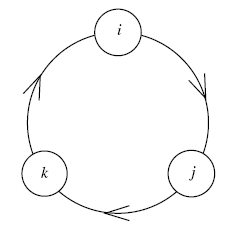Quaternion Basics

Let , and be quaternions whose values are
with , , and as the quaternion units following the property
If and is expressed in the form , with , , , and being integers, find .
The answer is 14.
This section requires Javascript.
You are seeing this because something didn't load right. We suggest you, (a) try
refreshing the page, (b) enabling javascript if it is disabled on your browser and,
finally, (c)
loading the
non-javascript version of this page
. We're sorry about the hassle.
Quaternions may be multiplied as you would any two polynomials, except that quaternion multiplication is noncommutative . That is, for any two quaternions P and Q ,
P × Q = Q × P
Starting from the identity i j k = − 1 , we can come up with the six different identities as follows:
i j = k j k = i k i = j
j i = − k k j = − i i k = − j
Nevertheless, the multiplication of more than two quaternions (provided that the order itself is unchanged) is associative.
~~~~~~~~~~~~~~~~~~~~~~~~
For two quaternions whose forms are a 1 + b 1 i + c 1 j + d 1 k and a 2 + b 2 i + c 2 j + d 2 k , you may just find its product as you would multiply any two polynomials, and then just substitute the products of quaternion units to their corresponding values. So for the above statement, the product would be
( a 1 + b 1 i + c 1 j + d 1 k ) ( a 2 + b 2 i + c 2 j + d 2 k ) = ( a 1 a 2 − b 1 b 2 − c 1 c 2 − d 1 d 2 ) + ( a 1 b 2 + b 1 a 2 + c 1 d 2 − d 1 c 2 ) i + ( a 1 c 2 + c 1 a 2 − b 1 d 2 + d 1 b 2 ) j + ( a 1 d 2 + d 1 a 2 + b 1 c 2 − c 1 b 2 ) k
~~~~~~~~~~~~~~~~~~~~~~~~
Now, the summation is expanded as follows: c y c ∑ A B C = A B C + B C A + C A B
So now, we do the calculations one at a time. Note that addition is still commutative, and that since multiplication is associative, one may choose any two adjacent quaternions as their starting point in each of the products.
~~~~~~~~~~~~~~~~~~~~~~~~~~~
For ABC, we will do ( A × B ) × C . We can also do A × ( B × C ) .
A B = ( 2 − i + j − k ) ( 3 + i − j + k )
= ( 6 + 1 + 1 + 1 ) + ( 2 − 3 + 1 − 1 ) i + ( − 2 + 3 + 1 − 1 ) j + ( 2 − 3 + 1 − 1 ) k
A B = 9 − i + j − k
now, multiplying this by C , we get
A B C = ( 9 − i + j − k ) ( 2 − i + j − k )
A B C = 1 5 − 1 1 i + 1 1 j − 1 1 k
~~~~~~~~~~~~~~~~~~~~~~~~~~
In a similar manner, we can compute B C A and C A B and get the following:
B C A = 6 + 2 i − 2 j + 1 4 k
C A B = 6 + 1 0 j + 1 2 k
and adding them, we get
A B C + B C A + C A B = 2 7 − 9 i − 1 9 j + 1 5 k
and there you have it. 2 7 − 9 − 1 9 + 1 5 = 1 4